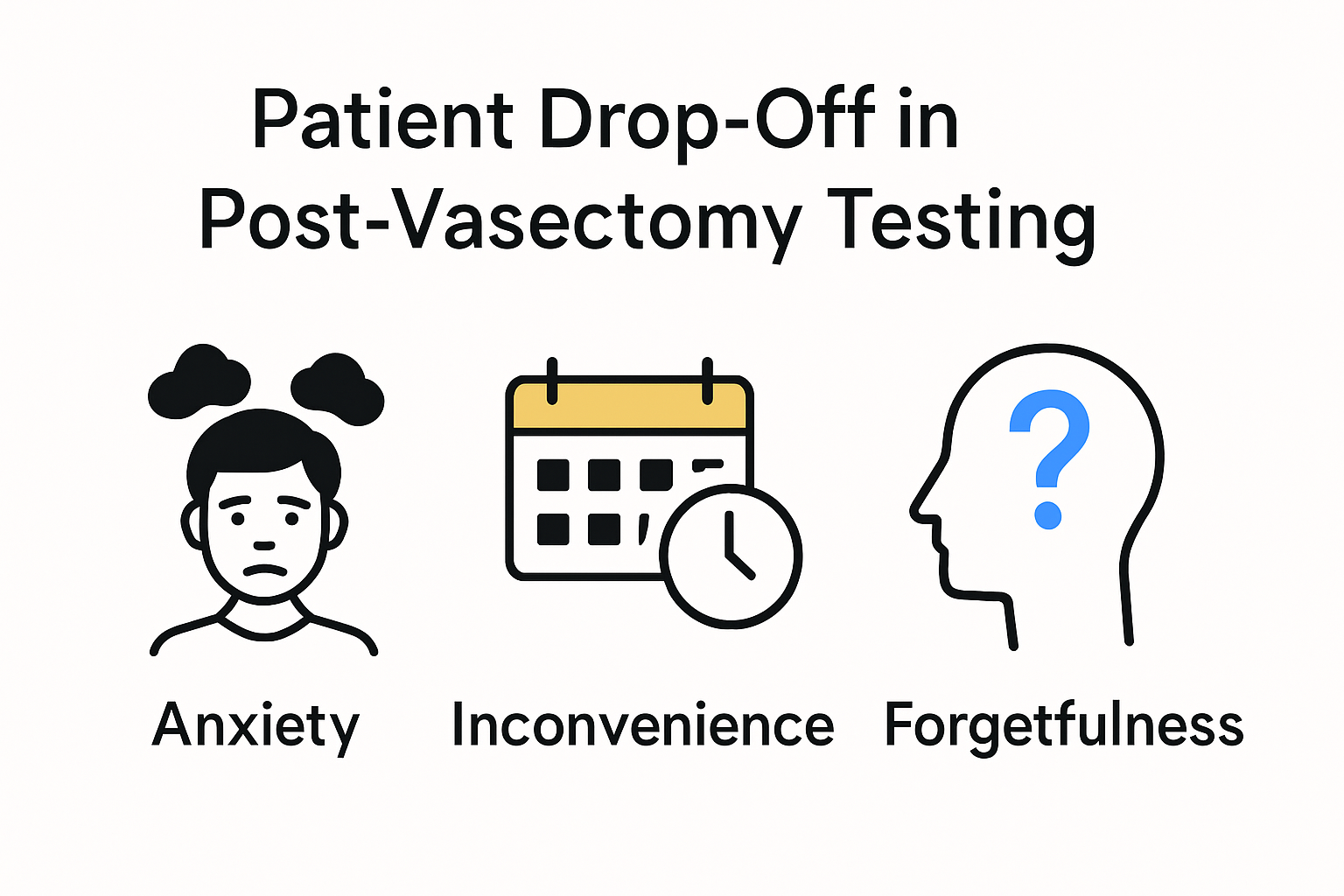Post vasectomy testing looks simple but is filled with hidden hurdles for both patients and clinics. Here is a shocker. Research shows that 30 to 40 percent of men skip or delay their required post-procedure semen test due to emotional and practical challenges. Most assume the hardest part is the surgery. The twist is that collecting and submitting a sample after the procedure causes far more confusion, stress, and missed appointments. So what is stopping men from finishing the process and how are clinics overcoming these stubborn obstacles? The surprising facts will challenge what you thought about male reproductive healthcare.
Table of Contents
Quick Summary
| Takeaway | Explanation |
| Specimen Collection Complexity | Fresh semen samples must be analyzed within two hours of collection, creating logistical challenges that can impact patient compliance and testing accuracy. |
| Psychological Barriers to Testing | Factors such as anxiety, embarrassment, and misconceptions about masculinity can hinder men’s willingness to complete post-vasectomy testing, leading to reduced follow-through. |
| Technological Advancements in Testing | Innovations in semen analysis, including AI and molecular detection methods, are enhancing the precision of post-vasectomy testing and improving patient outcomes. |
| Standardization of Clinical Protocols | The adoption of updated guidelines has reduced the need for multiple tests and improved communication, contributing to more efficient and accurate fertility verification. |
| Patient-Centered Testing Solutions | At-home testing options and simplified protocols prioritize patient convenience and privacy, potentially increasing compliance in post-vasectomy testing. |
Common Obstacles Facing Post Vasectomy Testing
Post vasectomy testing represents a critical final step in confirming male sterilization, yet patients and healthcare providers encounter numerous challenges that can complicate the process. Understanding these obstacles is essential for ensuring accurate fertility verification and patient compliance.
Specimen Collection Complexity
One of the most significant challenges in post vasectomy testing involves the intricate requirements for semen specimen collection. Research indicates that fresh semen samples must be examined within two hours of collection, creating substantial logistical hurdles for patients. Traditional clinic-based testing demands precise timing, transportation, and immediate laboratory processing.
Patients frequently struggle with these strict collection parameters. The need to produce a sample within a narrow timeframe, often requiring travel to a specific medical facility, introduces stress and potential errors in the testing process. This complexity can lead to reduced patient compliance and potentially incomplete fertility confirmation.
Clinical Communication and Patient Understanding
Miscommunication between healthcare providers and patients represents another critical obstacle in post vasectomy testing. Many men do not fully comprehend the importance of comprehensive semen analysis or the specific protocols required for accurate testing. Urologists must invest significant time in explaining the necessity of multiple test specimens and the potential for residual sperm presence.
Typical communication challenges include:
-
Unclear instructions about sample collection techniques
-
Insufficient explanation of why multiple tests might be necessary
-
Lack of understanding about potential false negative results
-
Anxiety surrounding the testing process
Technical And Procedural Limitations
Technical constraints within medical testing frameworks create additional challenges for post vasectomy verification. Standard semen analysis requires specialized laboratory equipment, trained technicians, and precise methodological approaches. Small variations in testing protocols can significantly impact result accuracy.
Moreover, the cost of repeated testing and the potential need for multiple specimens can be financially burdensome for patients. Some insurance plans provide limited coverage for post vasectomy testing, forcing individuals to absorb substantial out-of-pocket expenses.
The emergence of at-home testing solutions represents a promising response to these traditional obstacles. By offering convenient, private testing options that maintain medical-grade accuracy, these innovative approaches aim to simplify the post vasectomy confirmation process. Such solutions can potentially increase patient compliance, reduce logistical challenges, and provide a more comfortable experience for individuals seeking fertility verification.
Addressing these multifaceted challenges requires a comprehensive approach involving improved patient education, streamlined testing protocols, and leveraging technological advancements in medical diagnostics. Healthcare providers must remain adaptable and patient-focused to ensure effective post vasectomy testing outcomes.
Understanding Patient Compliance And Drop-off
 Patient compliance in post vasectomy testing represents a critical yet often overlooked challenge in male reproductive healthcare. The journey from vasectomy procedure to confirmed sterility involves multiple steps where patient engagement can significantly fluctuate, potentially compromising long-term reproductive management.
Patient compliance in post vasectomy testing represents a critical yet often overlooked challenge in male reproductive healthcare. The journey from vasectomy procedure to confirmed sterility involves multiple steps where patient engagement can significantly fluctuate, potentially compromising long-term reproductive management.

Psychological Barriers to Testing
The psychological landscape surrounding post vasectomy testing is complex and multifaceted. Many men experience anxiety, embarrassment, and uncertainty that directly impact their willingness to complete comprehensive fertility verification. Research from the Journal of Urology suggests that approximately 30-40% of men delay or avoid post vasectomy semen analysis due to emotional discomfort.
Key psychological obstacles include:
-
Performance anxiety related to semen collection
-
Fear of potential testing complications
-
Misconceptions about masculinity and fertility
-
General medical appointment avoidance
These emotional barriers create significant friction in the testing process, leading to reduced patient follow-through and potential reproductive health risks.
Practical Challenges In Testing Compliance
Beyond psychological factors, practical challenges substantially contribute to patient drop-off rates. Traditional testing protocols demand significant time investment, precise scheduling, and complex logistical coordination. Patients must navigate multiple appointments, transportation requirements, and strict sample collection protocols.
Additional practical impediments include:
-
Limited clinic hours and scheduling flexibility
-
Transportation challenges to specialized testing facilities
-
Work and personal schedule constraints
-
Financial burdens associated with repeated testing
These practical obstacles create substantial friction, making comprehensive post vasectomy testing feel overwhelming and inconvenient for many patients.
Emerging Solutions And Patient Engagement Strategies
Healthcare providers and technological innovators are increasingly developing strategies to address patient compliance challenges. At-home testing solutions represent a promising approach to reducing traditional barriers. By offering discretion, convenience, and simplified testing protocols, these methods can potentially increase patient engagement and follow-through.
Effective patient engagement strategies might include:
-
Clear, step-by-step educational materials
-
Simplified testing protocols
-
Digital tracking and reminder systems
-
Transparent communication about testing expectations
The future of post vasectomy testing compliance relies on creating patient-centric approaches that prioritize comfort, accessibility, and comprehensive education. Healthcare providers must recognize that reducing psychological and practical barriers is essential to ensuring accurate fertility verification.
Ultimately, successful patient compliance requires a holistic approach that addresses emotional, logistical, and educational dimensions of post vasectomy testing. By understanding and proactively mitigating patient concerns, medical professionals can improve overall testing rates and reproductive health outcomes.
Improving Accuracy And Communication In Testing
Accurate post vasectomy testing requires a sophisticated approach that integrates advanced technological capabilities with clear, transparent communication strategies. The precision of fertility verification directly impacts patient confidence and long-term reproductive health management.
Technological Advancements In Semen Analysis
Recent research from medical technology studies highlights significant challenges in detecting extremely low sperm concentrations. Current diagnostic technologies require substantial improvements to achieve reliable post-vasectomy testing precision. Advanced systems are developing innovative approaches to increase field of view and detection sensitivity.
Key technological considerations include:
-
Enhanced microscopic imaging techniques
-
Improved sperm concentration detection methods
-
Digital analysis algorithms
-
Reduction of human error in specimen interpretation
Technological innovations aim to address biological complexities such as sperm clustering and minute concentration variations that can compromise traditional testing methodologies.
Standardizing Clinical Communication Protocols
Updated American Urological Association (AUA) guidelines have significantly improved testing efficiency by streamlining communication and testing protocols. The guidelines have reduced the proportion of men requiring multiple post-vasectomy semen analyses from 39% to 31.1%, demonstrating the critical importance of clear, standardized communication.
Effective communication strategies should include:
-
Transparent explanation of testing requirements
-
Clear timelines for follow-up testing
-
Comprehensive patient education about potential outcomes
-
Detailed instructions for specimen collection
Healthcare providers must develop nuanced communication approaches that balance medical precision with patient understanding and comfort.
Emerging Testing Methodologies
The landscape of post vasectomy testing is rapidly evolving, with home-based testing solutions presenting both opportunities and challenges. Clinical research emphasizes the need for careful evaluation of these alternative testing methods, particularly regarding specimen handling and result accuracy.
Critical considerations for emerging testing methodologies include:
-
Maintaining specimen integrity during transportation
-
Ensuring consistent collection protocols
-
Validating home-based testing accuracy against clinical standards
-
Developing robust quality control mechanisms
The future of post vasectomy testing lies in creating flexible, patient-centered approaches that do not compromise medical accuracy. This requires continuous collaboration between technological innovators, healthcare providers, and patient communities.
Ultimately, improving accuracy and communication in post vasectomy testing demands a holistic approach. By integrating advanced technologies, standardized protocols, and patient-focused communication strategies, healthcare providers can enhance the reliability and accessibility of fertility verification processes.
Future Solutions For Vasectomy Confirmation
The landscape of vasectomy confirmation is rapidly evolving, driven by technological innovations, patient-centered approaches, and advanced diagnostic methodologies. Future solutions aim to address existing challenges while providing more accurate, convenient, and patient-friendly fertility verification processes.
Technological Innovations In Fertility Testing
Research from the European Medical Journal indicates that emerging technologies are transforming post-vasectomy testing strategies. The optimal testing window has been refined, with compliance and clearance rates converging approximately 5.7 weeks post-procedure, representing a significant advancement in testing precision.
Emerging technological solutions include:
-
Advanced molecular sperm detection techniques
-
AI-powered image analysis systems
-
Microfluidic testing platforms
-
Enhanced digital tracking mechanisms
These innovations promise to reduce human error, increase detection sensitivity, and provide more comprehensive fertility verification approaches.
Standardized Clinical Protocols
Updated American Urological Association guidelines demonstrate a progressive approach to standardizing post-vasectomy testing. The guidelines have successfully reduced the number of men requiring multiple semen analysis procedures from 39% to 31.1%, highlighting the potential for more efficient testing protocols.
Key protocol improvements focus on:
-
Streamlined testing requirements
-
More precise timing recommendations
-
Reduced unnecessary follow-up examinations
-
Enhanced patient communication strategies
Standardization efforts aim to create a more consistent, patient-friendly approach to fertility verification.
Patient-Centered Testing Solutions
The future of vasectomy confirmation centers on developing patient-centric testing methodologies that prioritize convenience, privacy, and accessibility. At-home testing solutions represent a significant leap forward in meeting patient needs and reducing traditional barriers to comprehensive fertility testing.
Critical components of patient-centered solutions include:
-
Discrete sample collection methods
-
Simplified testing protocols
-
Digital result tracking
-
Comprehensive educational support
By focusing on patient experience and technological innovation, healthcare providers can create more engaging and effective fertility verification processes.
The convergence of advanced diagnostics, standardized protocols, and patient-focused approaches represents the future of vasectomy confirmation. Healthcare providers must continue to invest in technologies and methodologies that balance medical precision with patient comfort and accessibility.
Ultimately, successful future solutions will require ongoing collaboration between technological innovators, medical professionals, and patient communities. By maintaining a flexible, forward-thinking approach, the medical community can develop increasingly sophisticated methods for confirming vasectomy effectiveness while prioritizing patient experience and scientific accuracy.
Frequently Asked Questions
What are the common challenges faced during post vasectomy testing?
Post vasectomy testing often involves issues such as specimen collection complexity, miscommunication between clinics and patients, and technical limitations in testing methodologies.
How can patients improve compliance with post vasectomy testing?
Patients can improve compliance by understanding the importance of the tests, utilizing at-home testing options, and establishing clear communication with their healthcare provider regarding the testing process.
What psychological barriers do men face after a vasectomy?
Men may experience anxiety, embarrassment, and misconceptions about masculinity, which can hinder their willingness to complete the necessary post-vasectomy semen analysis.
What technological advancements are being made in post vasectomy testing?
Innovations such as AI-assisted semen analysis, molecular detection techniques, and enhanced digital tracking systems are improving the accuracy and efficiency of post vasectomy testing.





